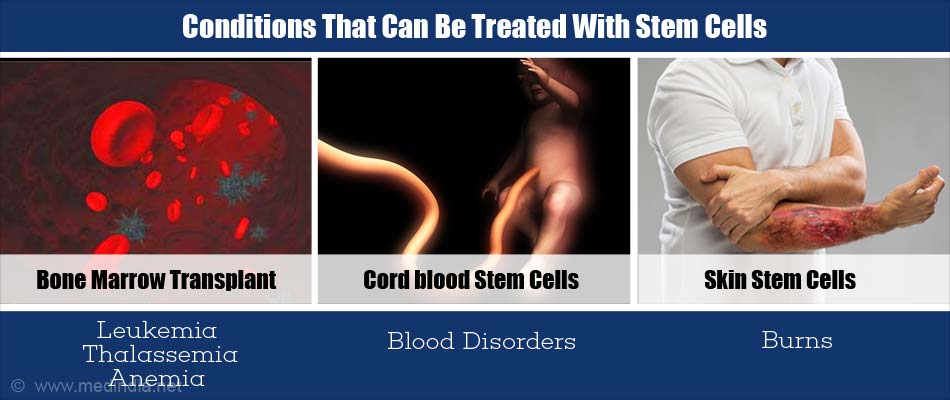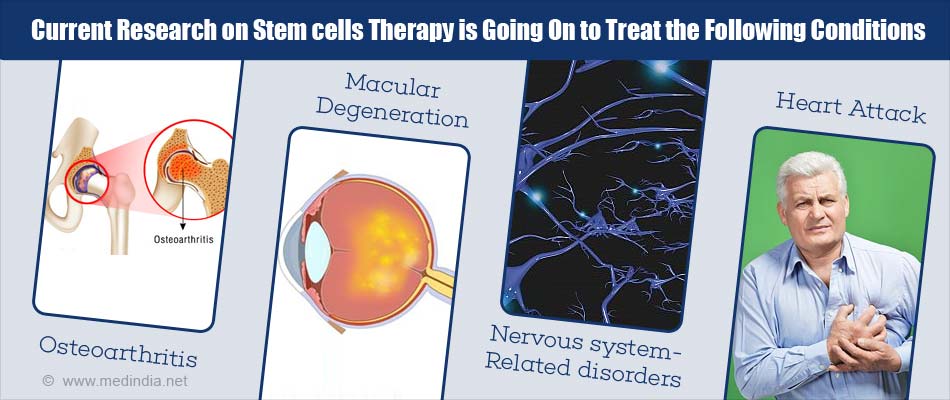- What diseases and conditions can be treated with stem cells? - (http://www.eurostemcell.org/what-diseases-and-conditions-can-be-treated-stem-cells)
- Stem cells - (http://www.closerlookatstemcells.org/learn-about-stem-cells/types-of-stem-cells)
- Stem Cell Basics - (https://stemcells.nih.gov/info/basics.htm)
- Stem cells: What they are and what they do - (http://www.mayoclinic.org/tests-procedures/bone-marrow-transplant/in-depth/stem-cells/art-20048117?pg=2)
What are Stem Cells?
Stem cells, simply put, – are undifferentiated cells present in both the embryonic stage and adult life. They have the capability of unlimited cell division and hence are called regenerating cells.
The fertilization of the female ovum by the sperm results in the formation of the zygote. The single cell then multiplies to form the whole human body consisting of billions of cells of different types. It forms the blastocyst after around five days. The blastocyst contains an inner cell mass called pluripotent stem cells. They are capable of forming all body organs.
In later life, some of our organs contain some specialized undifferentiated cells. These are called adult stem cells. They have been identified in many body organs, including the bone marrow, blood, brain, heart, intestine, liver, muscles, skin, teeth, ovaries and testis. These cells are found in specific regions of the organ called ‘stem cell niche’. They get activated in the presence of injury or degenerative changes and help in tissue regeneration. But in many cases, this natural process is slow or insufficient.
The third type of stem cells is iPS cells (induced pluripotent cells). These are adult differentiated cells that are engineered in the laboratory to behave as stem cells. These cells are being extensively researched to study disease progression and test novel therapeutic modalities.
Stem cells have two unique capabilities:
- The power to regenerate
- The power to differentiate
What is Stem Cell Therapy?
Stem cell therapy, also called regenerative medicine, is an upcoming medicine specialization that is centered on the utilization of stem cells to treat potentially incurable diseases. Stem cell therapy offers optimism in cases of degenerative diseases.
The loss or malfunction of an organ cannot be cured by current medical science interventions. Presently, organ transplantation is the only method to replace a dysfunctional or degenerated organ. Organs are in short supply, and many people face morbidity for years waiting for their turn for transplantation. Transplant organ rejection also remains a critical challenge. Donation of organs has picked up momentum but yet the demand-supply gap is staggering.
Stem cell therapy offers promise because the cells grown in the laboratory can be transplanted into the injured tissue to replace the lost cells and repair the tissue. Hence, the dependency on organ availability and matching is avoided. Usage of an individual’s own stem cells for regenerating a tissue or organ in the laboratory is an exciting possibility. This procedure is termed autologous transplantation. It is free of ethical constraints and minimizes chances of immune reaction and rejection.
How are Stem Cells Used in Treating Diseases?
Stem cell therapy essentially involves four key steps:
1. Source extraction
Stem cells are isolated from a healthy donor or in some cases from the patient’s own body. In the latter case, it is termed autologous stem cell therapy. Embryonal stem cells are obtained from embryos that are discarded following in vitro fertilization.
2. Stem cell harvesting in laboratory
This procedure involves the isolation of stem cells from the source sample, concentration and analysis of their behavior. The cells are then allowed to propagate.
3. Stem cell implantation
When sufficient cells are obtained, they are implanted into the patient’s body and allowed to differentiate into the desired tissue.
4. Post implant care
Close monitoring and care are required to detect any form of tissue rejection and treat it promptly. The immune system of the patient is suppressed with medication to avoid rejection of stem cell implant. This can also cause some complications.
If the process is successful, the new tissue replaces the old degenerated tissue and the organ function returns to normal.
What are the Diseases / Conditions that can be Treated with Stem Cells?
Bone marrow transplant has been the oldest form of stem cell therapy and the only type of therapy that has met with resounding success. It is used in the treatment of blood disorders like leukemia, aplastic anaemia or genetic disorders like thalassemia and sickle cell anaemia. A bone marrow transplant procedure involves transplanting immature blood cells called hematopoietic stem cells harvested from a healthy donor. These stem cells start producing healthy blood cells throughout the lifespan of the individual, thus potentially curing the disease.
Cord blood stem cells can be harvested from the umbilical cord at the time of birth. These cells are then cryopreserved, that is preserved at -196oC in liquid nitrogen to maintain the viability of the stem cells. The cells can be utilized in later life in case of any blood disorders or genetic diseases for the regeneration of tissues or organs. Although widely publicized as a blanket remedy to expectant parents, success in the preservation of stem cells and effective utilization remain limited.
Skin stem cells are being used to grow skin grafts in the laboratory, which can later be used to cover very large parts of the body affected by conditions like burns. The new skin however lacks sweat glands, sebaceous glands and hair follicles. Therefore, more research is necessary to develop skin that resembles the normal skin more closely. Limbal stem cells, obtained from the junction of the cornea and the sclera of the eye, have been used to repair the cornea of the eye that has been damaged by disease.

Current Research on Stem cells therapy
Stem cells are also being evaluated for possible use in the treatment of a number of conditions like:
- Osteoarthritis, which is a degenerative condition affecting the knees and the hip joint. Mesenchymal stem cells are being evaluated for the treatment of the condition
- Macular degeneration
- Nervous system-related disorders which include Parkinson’s disease, motor neuron disease, Huntington’s disease and spinal cord injuries
- Heart attack, to regenerate heart tissue
- Type 1 diabetes
Stem cell research offers great hope of understanding human development better and offers an unlimited opportunity of harnessing this technology for treating a variety of disorders in the near future. Numerous experimental studies are being conducted across the globe. Scientific and social implications are often in conflict and hence research is sluggish.
Many hurdles lie in the path of transforming stem cell research into stem cell therapy accessible to millions. The path holds immense promise, yet requires persistence, patience and optimism to become a reality.

Health Tips
Before venturing into becoming a recipient of stem cell therapy, it is essential to know the current scientific evidence in support of the treatment.
Patients should not get misled by marketing materials and testimonials.
No experimental therapy is clinically safe and should not be participated in without knowing the implications.








